There are so many types of German sausage, they’ve become a part of the language. Here in America, if we don’t have an opinion on where to go to dinner or what color shirt to buy, we say, “It’s all the same to me.” If a German guy doesn’t care what the office wants to order for lunch, he might say something like Das ist mir wurst, which translates literally to, “This means sausage to me,” but really means something closer to, “It doesn’t matter to me.”
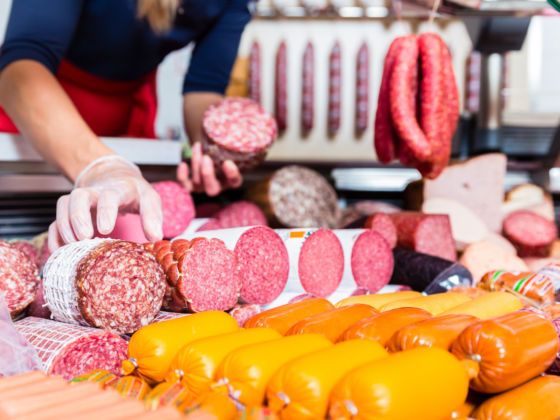
27 Types of Fermented, Smoked, and Spiced German Sausages You Need to Try
The sausage talk doesn’t end there. In Germany, in fact, a great many idioms are based around the sausage. “Everything has one end, only the sausage has two” references the fact that all good things come to an end. “Throw the sausage after the bacon” reminds Germans that sacrifice might result in a triumph down the line. In Germany, sausage is the basis of more than a diet: It influences language and culture, too.
The German love affair with this hearty meal should not come as a surprise: Sausages, alongside heaping helpings of kale and potatoes and a side of tangy sauerkraut, sustained farmers. Cured, dried, and smoked sausages could be carried over long journeys by both hunters and soldiers. Sausage is nourishing, and it can last through the winter when all other food stores are low. What’s not to love!
- Types of German sausage
- The most popular German sausages
- What is the best German sausage?
- What are the top six most popular sausages in Germany?
- What is German pork sausage called
- What is the biggest German sausage?
- What is the spiciest German sausage?
Types of German sausage
There are likely 1,500 types of German sausage. German sausage falls into a few different categories: brühwurst (cooked sausages that are scalded, roasted, or baked), kochwurst (steamed or boiled sausage that can be served hot or cold), and grützwurst (sausages that contain groats, or cereal grains). Today, sausages figure into all facets of German life: Some are beloved street foods, others are served at breakfast topped with a fried egg, and still others are dipped in mustard and eaten with beer. Here are 27 you need to know about.
The most popular German sausages
1. Bierwurst
This dark red, garlic-heavy variety of brühwurst is seasoned with black peppercorns, paprika, and mustard seeds to give it a pungent, spicy flavor. Bierwurst is made from ground pork and beef but contains no actual beer. Instead, slices of this Bavarian sausage are commonly accompanied by a glass of beer. It’s also sometimes used as a sandwich filling.
2. Bockwurst
This smoked German sausage is made from pork and veal and is lightly seasoned with salt, white pepper, and paprika. A sprinkle of chives or parsley is sometimes added for a dash of color and extra aromatic flavor. Bockwurst originated in Bavaria, likely in the mid-1500s, where it was first consumed with bockbier, a type of German lager. Another urban legend claims that it was invented much later, in 1889 by a restaurant owner from Berlin named Robert Scholtz, for a party commemorating the end of the school year at Humboldt University.
3. Bratwurst

Photo: Christin Klose/Shutterstock
There are many different varieties of bratwurst, but in general, this German sausage is fresh (rather than cured or smoked) and made from either ground beef, veal, or pork. It probably originated in Bavaria or Thuringia in the early 1300s. In modern Germany, bratwurst is pan-fried or roasted. It can be served on a bun, with mustard, alongside sauerkraut, potato salad, or rye bread. It’s a popular dish at pubs and can be found at street food stalls around the country.
4. Bregenwurst
A product of the Schleswig-Holstein and Saxony-Anhalt regions of Germany, bregenwurst is sometimes also known as cabbage sausage. The main ingredient in bregenwurst, aside from pork or pork belly, is pig or cattle brain, though most modern versions rarely contain brain anymore due to concerns over mad cow disease. Traditionally, bregenwurst is served with, or cooked in, a hearty helping of kale.
5. Cervelat
Also a favorite sausage of the Swiss, cervelat is seasoned with pungent mustard and garlic. In Germany, it’s made from pork, beef, and bacon. Cervelat is smoked and cured, which means that these hearty sausages can be eaten cold, straight from the refrigerator. Cervelat can also be grilled and the ends sliced open to create an almost open flower look at the end of the sausage.
6. Currywurst
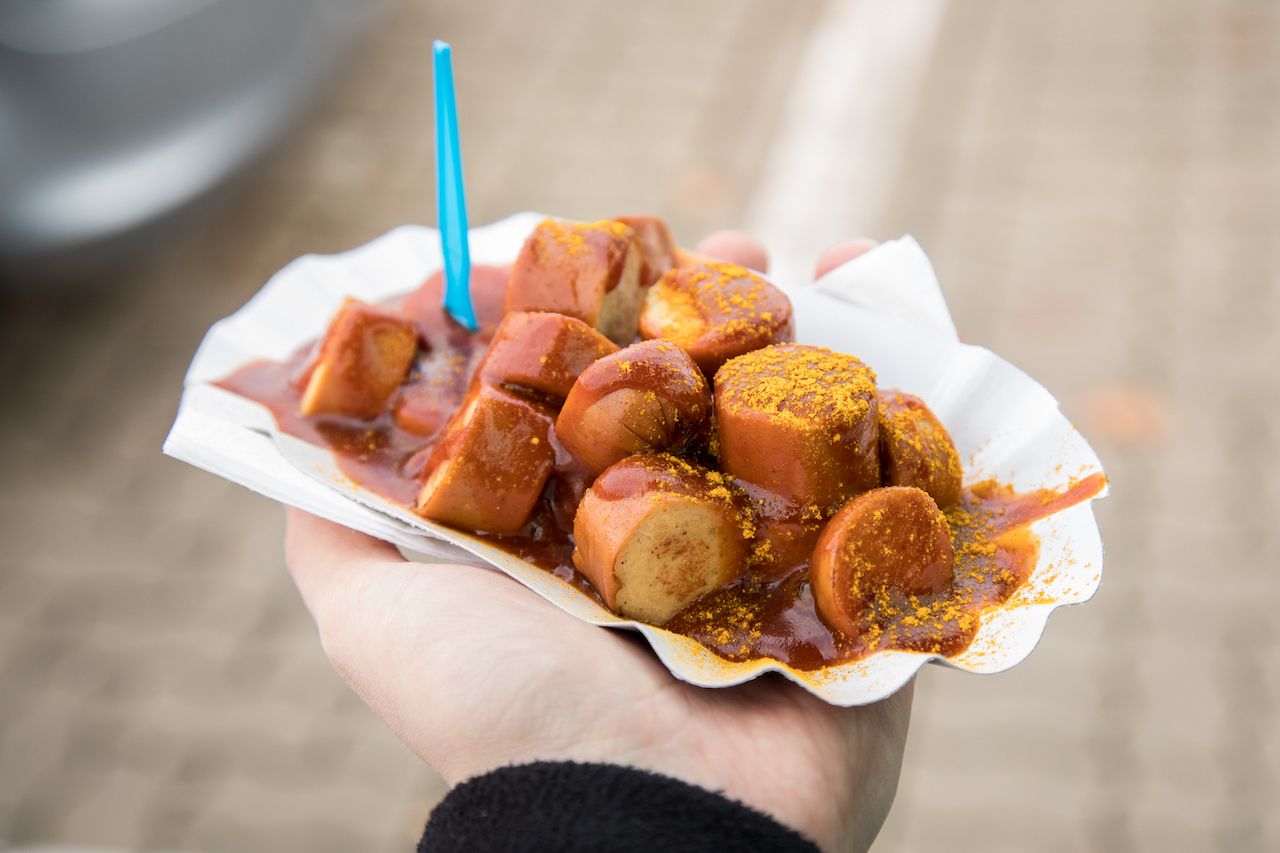
Photo: Christin Klose/Shutterstock
This fast-food snack popular in Berlin is a fried pork sausage topped with curry powder and spiced ketchup, and it’s sometimes sliced and served with fries. A German housewife named Herta Heuwer invented currywurst in postwar Berlin when she traded spirits for ketchup with a British soldier. Though it’s considered an inexpensive street food, currywurst has an egalitarian appeal in Berlin, beloved by just about everyone.
7. Fleischwurst
This mildly smoked sausage comes from France, but it’s a popular snack in Germany and is better known as bologna in the United States. Fleischwurst is sometimes spiced with cardamom, ginger, nutmeg, or coriander, and is served in a horseshoe-shaped ring.
8. Frankfurter rindswurst
In 1894, a butcher named Karl Gref conceived this type of beef frankfurter to serve the growing Jewish population of Frankfurt, which couldn’t eat pork sausage. His shop, Gref-Voelsing, is still open and serving frankfurter rindswurst on a small bun with mustard. A law passed in 1929 in Germany decreed that only sausages in Frankfurt may legally use the term frankfurter.
9. Frankfurter Würstchen
These long, thin sausages also hail from Frankfurt. Frankfurter würstchen are smoked and must be made entirely from pork. Frankfurter würstchen are boiled for several minutes in order to keep the casing intact and are then served with bread and mustard or alongside potato salad.
10. Gelbwurst
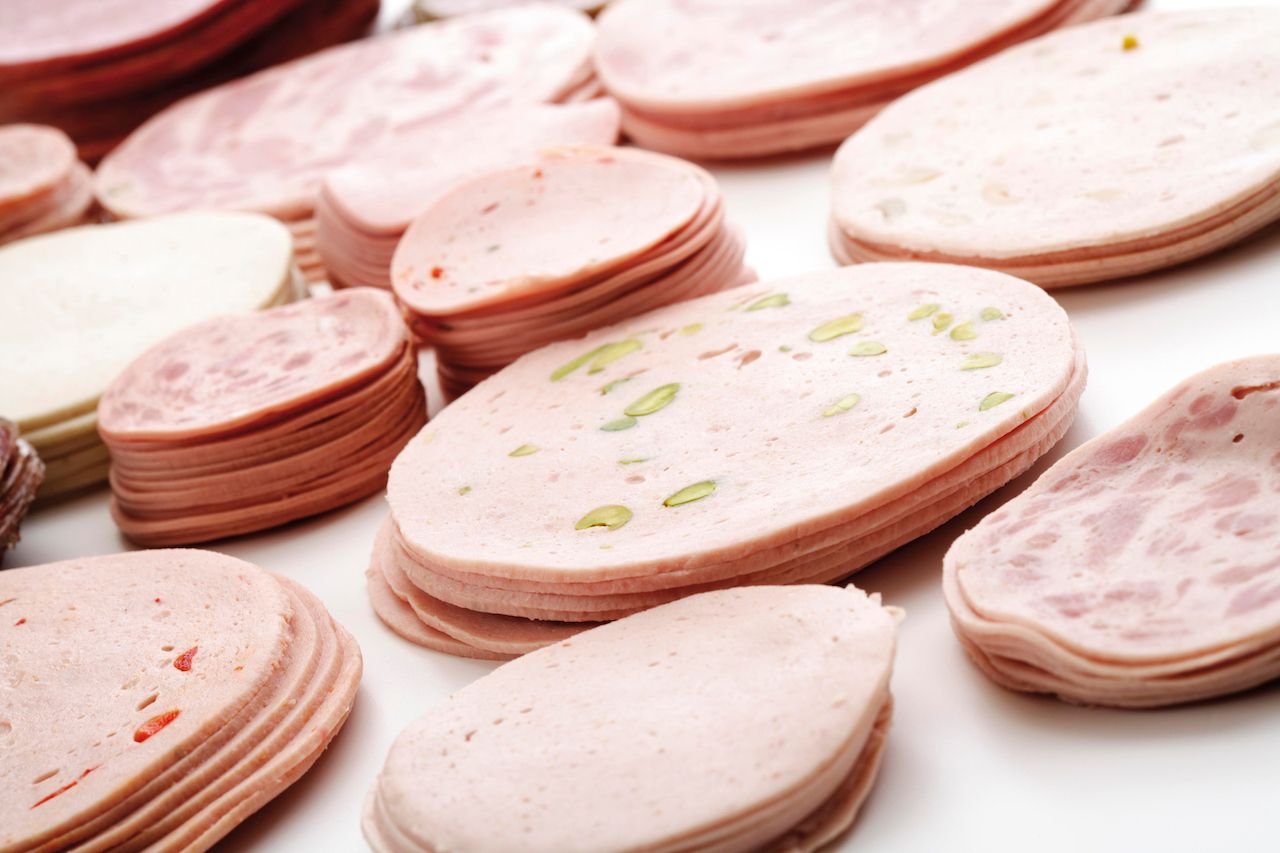
Photo: imageBROKER.com/Shutterstock
First prepared in the Black Forest region of Bavaria, gelbwurst is nearly white in color and is encased in a pale yellow rind (traditionally pig’s intestine dyed with saffron). This sausage is typically served as lunch meat, and its mild flavor makes it popular among children. The original version, first introduced in 1905, contained pig’s brains, though that is rarely the case anymore.
11. Jagdwurst
Nicknamed “hunting sausage” because it’s easy to eat on the go, jagdwurst is cut into thin rounds like lunchmeat. It’s sometimes considered the German bologna, similar to fleischwurst. Seasoned with just a touch of garlic, jagdwurst is mild in flavor and has a marbled texture when sliced.
12. Kohlwurst
This fermented sausage is another variety often cooked with kale or cabbage. Kohlwurst is made primarily from pork fat and pork lung, seasoned with allspice and mustard seeds, and smoked for as long as two weeks.
13. Knackwurst

Photo: Nagy Julia/Shutterstock
This sausage hails from the Holstein region, in northern Germany. Knackwurst is lightly smoked and seasoned mostly with garlic. Knack can be translated to snap or crackle, which refers to the way it becomes crispy once grilled. Knackwurst is an especially plump and juicy sausage and is often served with sauerkraut.
14. Knipp
This variety of grützwurst, a German sausage from the Bremen region that’s mixed with grains, is made by combining pork head, belly, rind, and liver with oats, which is seasoned with allspice and pepper then smoked. Knipp can be served in slices with boiled potatoes or fried with butter and spread on toast for breakfast. Knipp is probably the inspiration for goetta, the sausage grain patties served at breakfast that are a beloved dish in Cincinnati.
15. Landjaeger

Photo: Olaf Speier/Shutterstock
Popular throughout southern Germany, Switzerland, and Austria, this smoked and dried sausage is a popular snack for hikers and other outdoor enthusiasts because it’s easy to slip inside your pocket and pack to munch on throughout the day. Jäger means hunter in German, alluding to its popularity among outdoorsmen and soldiers who needed sustenance during long journeys.
16. Leberkäse
Leberkäse is similar to meatloaf. It’s a block of ground corned beef, pork, and bacon that’s baked in a bread tin and served in thick slices, and it’s often served topped with a fried egg. The crunchy brown crust on the outside is considered the most delicious part of leberkäse. One story says that it was invented in Bavaria in 1776, but it remains unsubstantiated.
17. Liverwurst
Liverwurst is eaten all over Europe, but in Germany, this soft sausage, made from calf or pig liver, is typically spread on toast and paired with pickles, as its consistency is similar to that of a pate. Onions or bacon can also be added to the recipe depending on the region. For instance, Thuringian liverwurst contains braised onions and ground pepper, and 51 percent of the ingredients must come from Thuringia, according to EU regulations.
18. Mettwurst
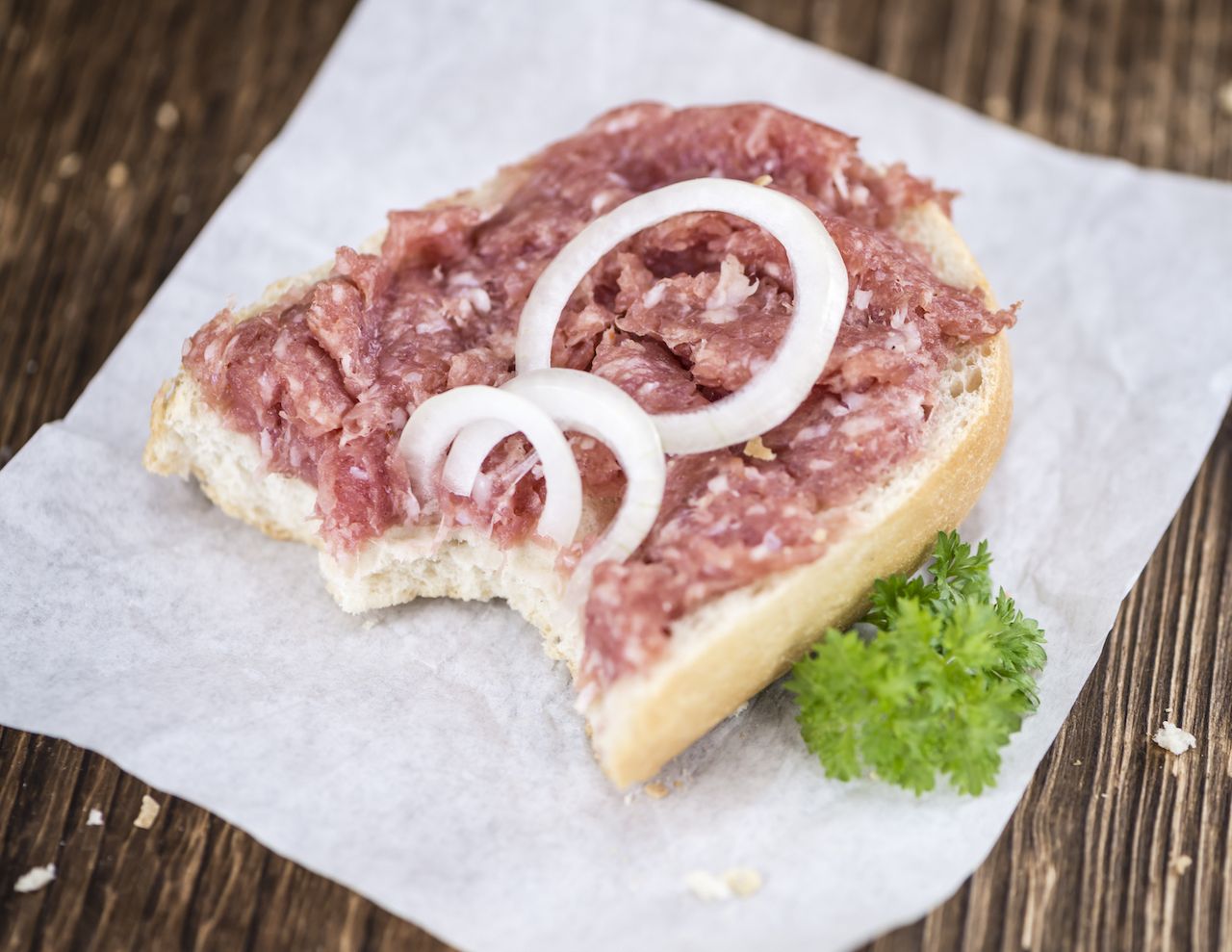
Photo: HandmadePictures/Shutterstock
Mettwurst is a smoked and cured sausage. The texture of mettwurst can vary: Sometimes it’s smoked for long enough that casing produces a satisfying “snap” when you bite into it, but there are also varieties of mettwurst that are soft and spreadable, like liverwurst. The flavor of mettwurst tends to be stronger than most mild German sausages, usually imparted by garlic, pepper, and the addition of a liquor like rum.
19. Nürnberger rostbratwurst
These finger size pork sausages hail from the Bavarian city of Nuremberg, as the name suggests. Nürnberger rostbratwurst might have first appeared in German cuisine in the early 1300s, but by the 16th century, demand for the sausage had dropped. Butchers devised a clever scheme: Make the sausages smaller and thinner so they would be cheaper to produce. But some legends also suggested that their diminutive size arose from the fact that they were passed through keyholes by innkeepers to hungry customers locked out after curfew or snuck through the walls in prisons to hungry inmates. Nürnberger rostbratwurst are grilled or pan-fried and often served in a roll of three to 12 with a side of potato salad or sauerkraut.
20. Pinkelwurst
Traditionally served with kale or potatoes, the pork filling in this sausage is paired with oats and onions. Pinkelwurst is considered a variety of grützwurst — sausages with groats (cereal grains). Pinkelwurst is especially popular in northwest Germany.
21. Rotwurst
Rotwurst is just one variety of German blutwurst, or blood sausage, and is made with pork blood, liver, speck (pickled pork belly, similar to bacon), and groats (cereal grains). The mixture is seasoned with cinnamon, cloves, and thyme, then cured with salt. In Thuringia, rotwurst is known as the “queen of blood sausage.”
22. Saumagen

Photo: 1eyeshut/Shutterstock
Meaning “sow’s stomach,” this dish comes from the Paltz region of Germany and is similar to Scottish haggis. The casing for saumagen is pig’s stomach, which is stuffed with a mash of pork meat, carrots, onions, and potatoes seasoned with pepper, thyme, and garlic among other spices. The origins of the dish are disputed, but some stories suggested it was invented in the 18th century as a way to reuse leftovers.
23. Stippgrütze
Similar to knipp, stippgrütze consists of barley mixed with offall, such as heart, kidney, or liver. The high fight content of stippgrütze has two plus sides: It can be preserved to be eaten throughout the winter, and it can be fried without adding any additional oil or fat to the pan. Stippgrütze is taken out of its casing and cooked and served with sides like a potato hash or mashed potatoes with bread and a side of gherkins.
24. Sülze
Sülze is technically a head-cheese cold cut made primarily from the meat from the head of a calf or pig that’s set in jelly. In Germany, head cheese has a tangy flavor because pickled vegetables or vinegar are sometimes added to the jelly alongside the meat. Sülze is molded into the shape of a loaf and served in slices. Other varieties are made with beef tongue or blood sausage.
25. Teewurst
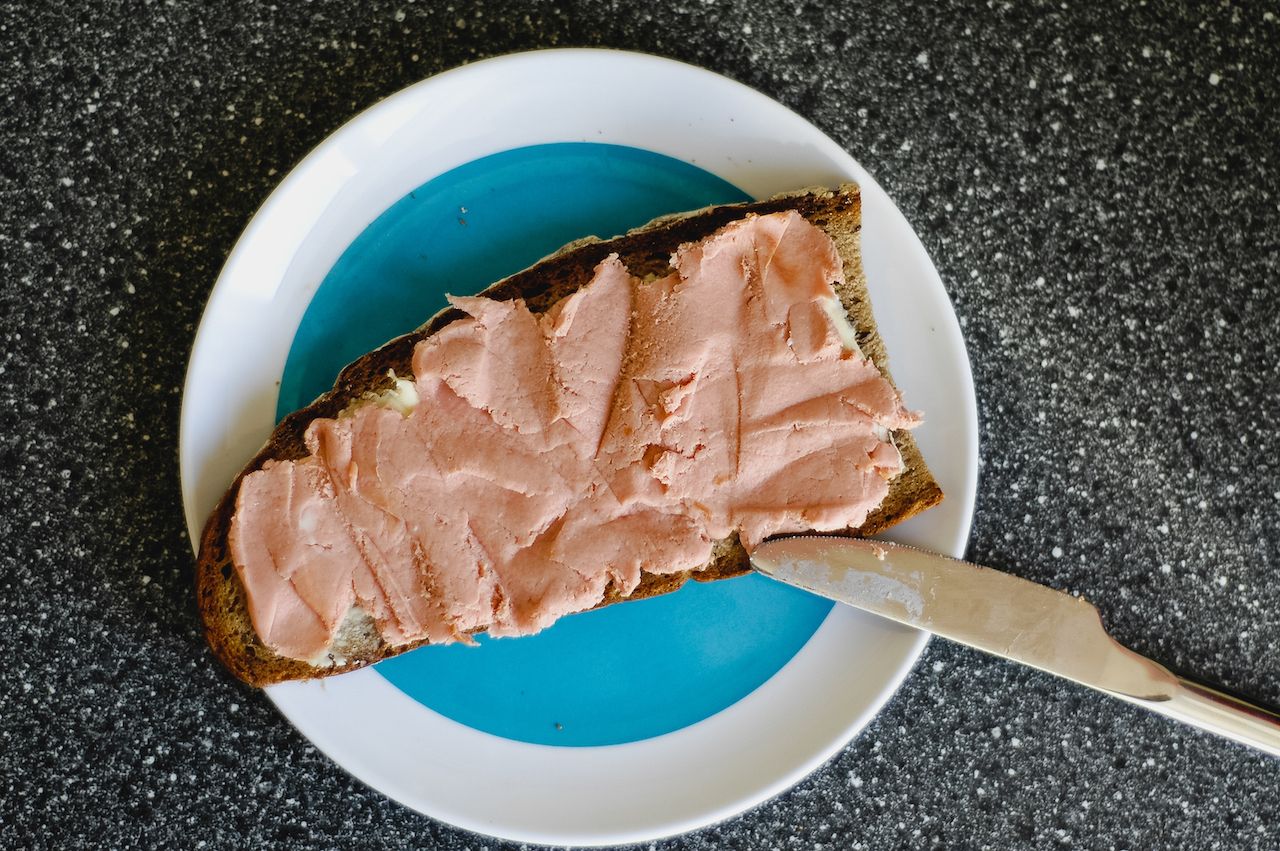
Photo: Corinna Haselmayer/Shutterstock
Similar to mettwurst, this sausage is meant to be spread on crackers and is served as a snack, often alongside tea as the name suggests. Teewurst is seasoned with white pepper, ginger, paprika, and cardamom, and rum, brandy, or cream are sometimes added as well. The meat spread likely first emerged in the Baltic region of Rügenwalde, which is modern-day Poland, in the 18th century.
26. Thüringer rostbratwurst
The Weimar State Archives cataloged the first official recipe for these sausages all the way back in 1613. Thüringer rostbratwurst is long and thin and is among the spiciest of the German sausages — seasonings typically include coriander, caraway seeds, and garlic. The traditional preparation is roasting or grilling over charcoal. These sausages have been bestowed with protected geographical indication (PGI) status, meaning that, similar to Thüringian liverwurst, 51 percent of ingredients to make the sausage must be from the region to be called true Thüringer rostbratwurst.
27. Weisswurst

Photo: Oxie99/Shutterstock
Weisswurst are a white German sausage from Bavaria. Made from veal and pork, weisswurst are seasoned with a fresh assortment of herbs and vegetables including onions, parsley, and lemon zest, as well as earthy herbs like ginger and nutmeg. According to one legend, an innkeeper invented the sausage in 1857 when he used pork chasings rather than those of sheep for his sausages, which he boiled instead of grilling. Today, weisswurst don’t contain any preservatives, so they are typically eaten as a morning snack, before the meat goes bad.
What is the best German sausage?
The best German sausage is subjective, and probably up to a matter of taste. When it comes to the most popular and well known German sausage, the answer is easy: That would be bratwurst. Made from either veal, pork, or beef, it’s typically seasoned with spices like ginger and coriander. Bratwurst is delicious grilled, and served in a hot dog bun, topped with relish and spicy mustard.
What are the top six most popular sausages in Germany?
The top six most popular German sausages might be hard to determine, unless you were to do some statistical analysis of the most purchased sausages in Germany. What we can determine with more ease is bratwurst, along with currywurst, bockwurst, weisswurst (white sausage), and leberkäse, which is similar to bologna.
What is German pork sausage called
There are many different types of German pork sausage. Bratwurst can be made with pork (or veal). Weisswurst, bierwurst, bockwurst, and frankfurter würstchen are all made either entirely or partially with pork.
What is the biggest German sausage?
The biggest German sausage is probably Thüringer rostbratwurst. Although it’s thin, it’s very long and usually served in a small bun, making it look even larger. Mettwurst is also another German sausage than is much longer than most other varieties.
What is the spiciest German sausage?
The spiciest German sausage might be Thüringer rostbratwurst, which is seasoned with garlic and bitter, anise-flavored caraway seeds. Leberwurst, or liver sausage, is made with pig liver, and has the consistency of a pate. It’s also considered spicy.